
WHAT YOU see here is Mitsubishi’s new 2019 MR Triton. It’s not so much of an all-new model but more a mid-life refresh of the fifth-generation MQ that arrived in Australia four years ago.
Most obviously the MR brings distinctive new stying, but there’s also new active safety kit and, the most significant mechanical change, the adoption of a new six-speed automatic that replaces the previous five-speeder.
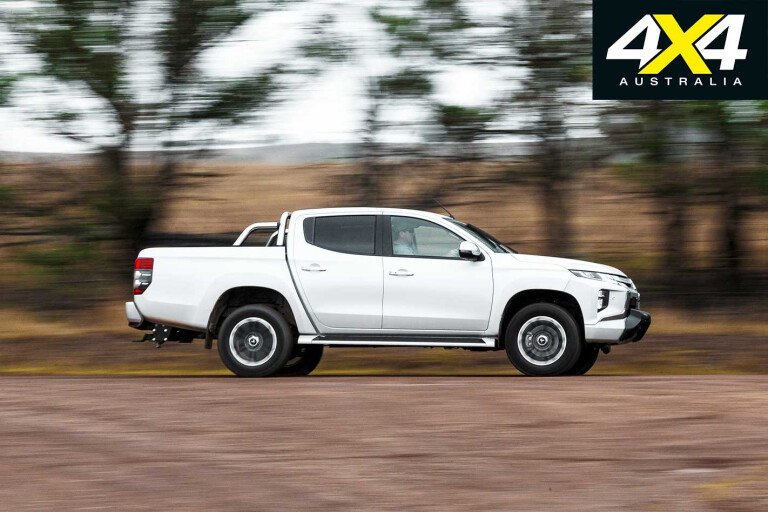
This evolution rather than revolution approach is very much Mitsubishi’s way when it comes to the Triton, as this new model can trace its roots back to the ML of 2006, the first of the Tritons where the rear of the cabin has the distinctive rounded-off styling.
In between then and now new engines have been the most notable changes, with a 3.2 diesel making way for a 2.5 diesel and most recently a 2.4 diesel, all the while offering more power and lower emissions. Meanwhile extra ratios have been added to both the manual and automatic gearboxes.
In a very crowded and very competitive dual-cab market the Triton is outsold only by the Hilux and Ranger, thanks largely to pricing only bettered by Chinese, Indian and now Korean utes. And while this new Triton is a little more expensive than the outgoing model it’s still the least expensive of the mainstream dual-cabs, with prices starting below $40K for a dual-cab 4x4. However, what we have here isn’t the least expensive Triton but the top-spec GLS Premium, which is $52K plus on-road costs.
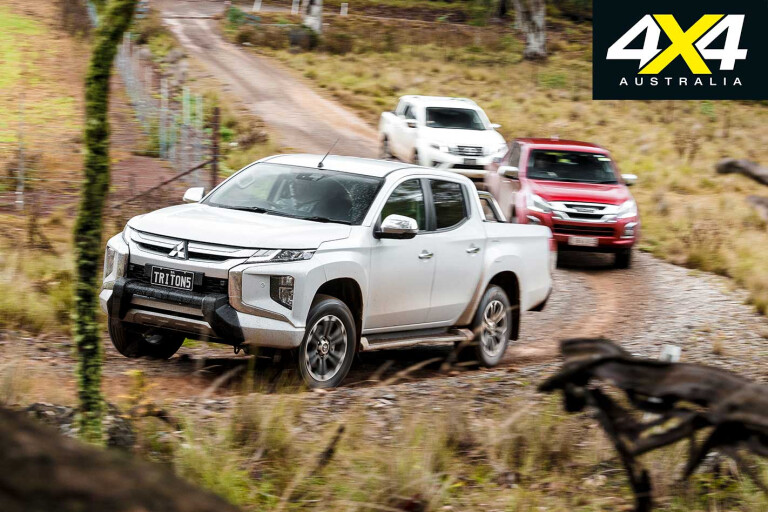
To keep the Triton honest we have two of the other less expensive mainstream utes in the form of Nissan’s Navara D23 and Isuzu’s D-Max. Like the predecessor of this new Triton the Navara D23 first appeared in 2015 but has been updated twice in quick succession, the last time early in 2018. What we have here is a top-spec Navara ST-X, which is $54K plus on-roads.
The D-Max effectively dates back to 2012; although, it received a significant powertrain upgrade in 2017 and some chassis tweaks a year later. Our mid-spec LS-U test vehicle is $51K plus on-roads.
ISUZU D-MAX LS-U - Working Man
While not the flashiest or most sophisticated ute on the market, the D-Max has slowly gained in popularity thanks largely to its robust and reliable powertrain.

THIS generation D-Max arrived in Australia in 2012 and unlike every other ute that Isuzu had produced up until that time – familiar here as the Holden Rodeo – this D-Max isn’t a 100-per-cent Isuzu product from the ground up.
The chassis and body shell actually owe more to General Motors; although, the engine, gearbox, transfer case, rear axle, suspension springs and dampers, interior fit-out and exterior body parts are all very different to what GM sells here as the Holden Colorado.
Unlike Holden, which initiated an ongoing revision program with its Colorado right from the get-go – no doubt to help bridge the gap to Ford’s superior Ranger – Isuzu left the D-Max alone until 2017 when mandatory compliance to tougher (Euro 5) emission regulations brought a significantly revised engine along with new six-speed manual and automatic gearboxes (replacing the previous five-speeders), additional NVH control measures and equipment upgrades.
The most recent changes for the 2018 model see all SX, LS-U and LS-T dual-cabs with more compliant three-leaf rear springs designed to improve the unladen ride. LS-M models retain the five-leaf springs.
Powertrain and Performance
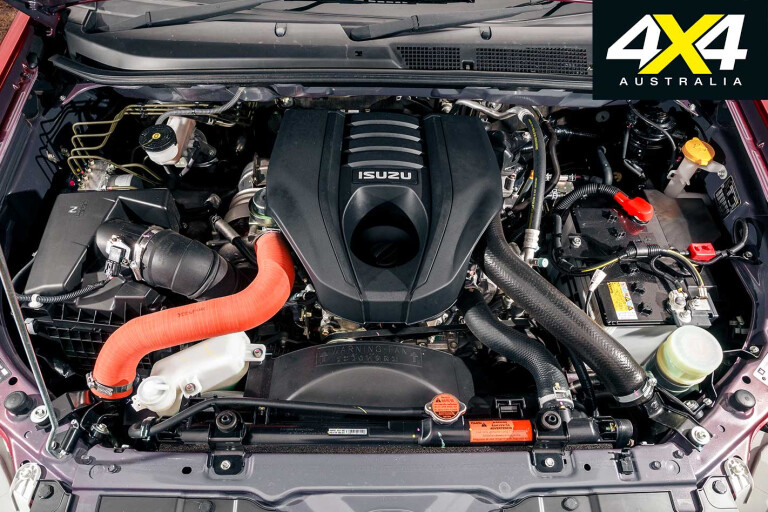
THE D-Max’s 3.0-litre four-cylinder diesel, now a big capacity engine in its class, traces back to 2006 when it first appeared here in the Holden Rodeo. Since that time there have been a number of updates, the most recent of which has brought higher-pressure common-rail injection, a new variable-geometry low-inertia turbo and new pistons. A diesel particulate filter (DPF) is the key Euro 5 technology that is found on all three engines here.
Despite all these MY17 engine changes maximum power remains at a modest 130kW (the lowest here) and, while maximum torque is now 430Nm (up from the previous 380Nm), it’s an equal-low figure here.
On the road there’s not much between these three utes with pedals to the medal, even if the D-Max tails the field. In general give-and-take driving, though, it does better with strong response from low engine speeds.
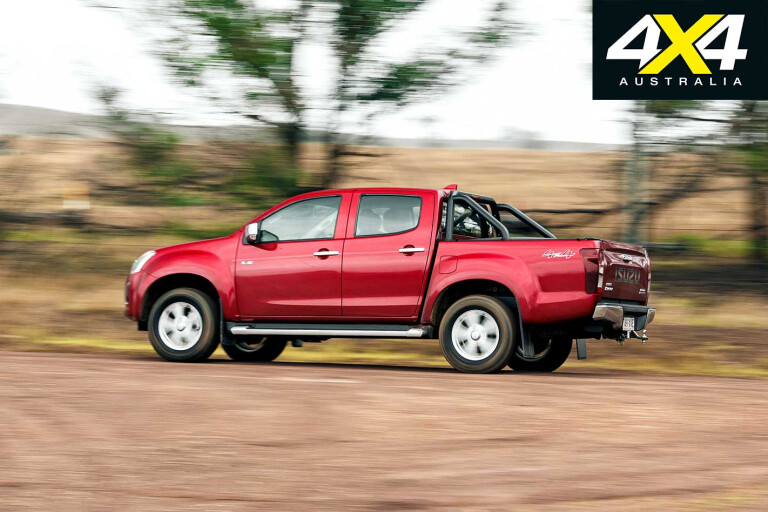
With its latest changes the D-Max is quieter than before, especially on light throttle running as you reach highway speeds on level roads. In this sort of environment it’s quieter than the Navara and a match for the generally more refined Triton. When asked to work on steeper hills or when overtaking it becomes noisy and the most agricultural-sounding of these three, which could be attributed to it being the largest capacity engine here.
The six-speed automatic (an Aisin, essentially the same unit in the Hilux, Fortuner and Prado) offers smooth and generally well-timed shifts and is notably proactive in the way it downshifts on off-throttle descents without brake prompts from the driver. The two very tall overdrive ratios (again like the Hilux) still means the gearbox is more about economy than performance, and the D-Max can shuffle back and forth between fifth and sixth on undulating country roads.
On-road ride and Handling
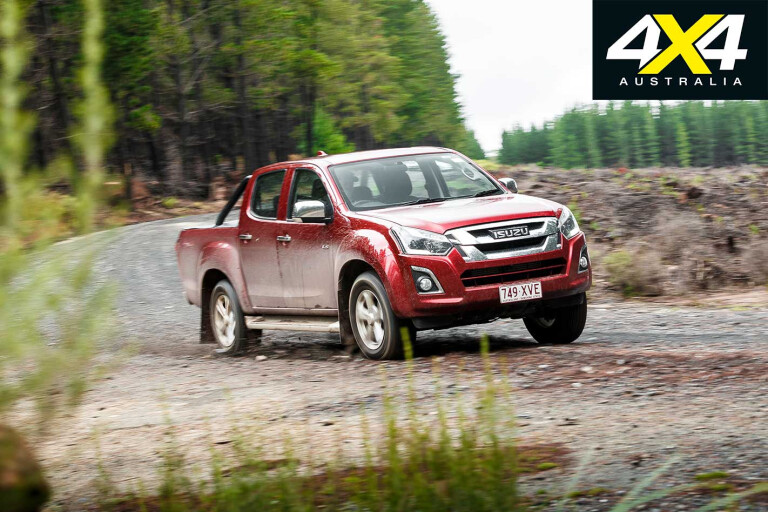
THE D-Max’s more compliant and slightly softer rear suspension makes for a generally agreeable unladen ride, and on most rough surfaces the D-Max has the best ride of three utes. It rides better than the Triton all the time and better than the Navara most of the time, even if there’s not much between it and the much-improved Nissan. Of the three the D-Max has the heaviest steering and one that lacks the feel of the sportier Triton.
Unlike its Colorado cousin, with its low-effort-yet-communicative electric power steering, the D-Max relies on conventional hydraulically assisted steering. The D-Max still handles well, but the bar isn’t set all that high in the company. VW’s Amarok almost feels like a sports car against this lot, and Ford’s Ranger and Holden’s Colorado are also well ahead in terms of on-road steering and dynamics.
Off-road
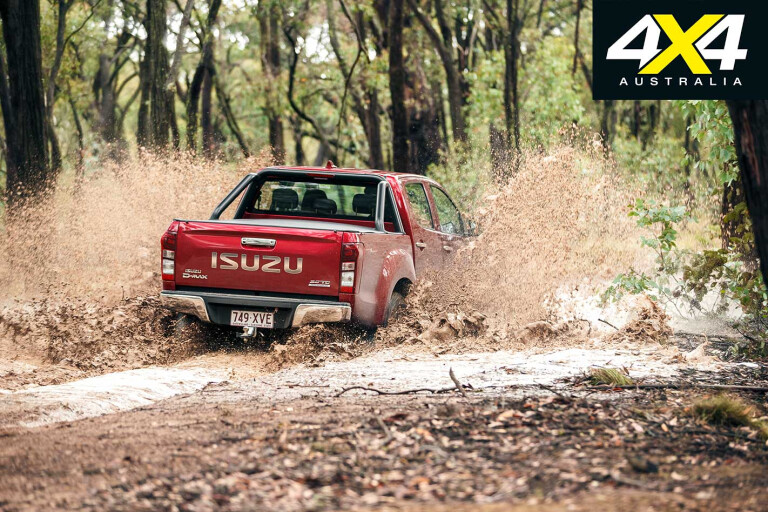
THE bar’s also not set particularly high amongst this trio in terms of off-road prowess as all three sit at the bottom of wider class of dual cab 4x4s when it comes to getting dirty.
From this lot to the best in class (Hilux, Ranger and Amarok, not necessarily in that order) there’s a fair gap in off-road prowess but at least the D-Max is still arguably the best here.
It could be a lot better if Isuzu would do what Holden did to the Colorado in 2016, namely add off-road specific calibration to the electronic traction control.
As it is, the D-Max’s modest wheel travel, lack of a rear locker and road-tune traction control are all limitations but in this company it has the best ground clearance and the added benefit of a solid bashplate, two decent front recovery points and inner-mudguard engine air intake. In terms of going off-road without modification of any type, the D-Max is the most ready of this trio even if it’s not technically the most capable.
Cabin and Safety

THE recent D-Max upgrades have brought a noticeably better-finished cabin than before and more equipment (such as sat-nav on this mid-spec model), but the general dash and cabin presentation is still the poorest here.
The D-Max has a marginally bigger cabin and good driver comfort, even if the steering wheel doesn’t adjust for reach. At the rear it’s also the best for three adults with more legroom, even if it’s no wider than the Navara. None of these three are all that good for three adults in the back – two adults and a child at best.
Six cabin airbags help contribute to a five-star ANCAP safety rating, but at this stage the D-Max doesn’t offer active safety features such as autonomous braking.
Practicalities
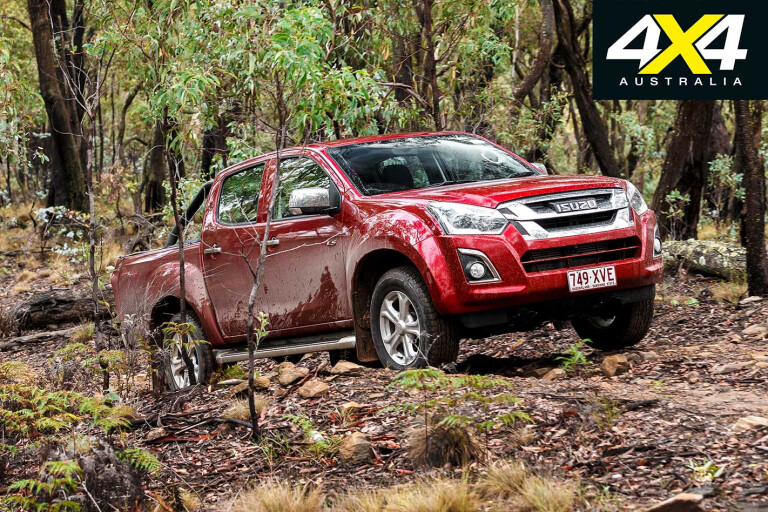
DESPITE the D-Max getting more compliant rear springs for most models in the MY18 upgrade the GVM of 4x4 models increased by 100kg to 3050kg, which is a welcome upgrade for fitting accessories or carrying a load.
The D-Max offers class-competitive payloads and a class-equal-best 3500kg tow rating and, while we tested neither here, when put to the test previously with a big load the D-Max has performed honestly without being a front-runner.
In more general practical terms the D-Max offers a surprisingly wide dealer network (142 dealers nationally at last count) despite Isuzu Ute only setting up shop in Australia in 2008. In the meantime the D-Max has earned a good reputation for reliability, simplicity of service and low service costs. Plenty of aftermarket support off the back of its strong sales, too.
ISUZU D-MAX LS-U SPECS:
Engine: 3.0-litre 4-cyl turbo-diesel
Max Power: 130kW @ 3600rpm
Max Torque: 430Nm @ 2000rpm
Gearbox: Six-speed automatic
4x4 System: Dual-range part-time
Crawl Ratio: 33.3:1
Construction: Separate-chassis
Front Suspension: Independent/coil springs
Rear Suspension: Live axle/leaf springs
Wheel/Tyre: 255/65R17 110S
Kerb Weight: 2021kg
GVM: 3050kg
Payload: 1029kg
Towing Capacity: 3500kg
Towball Download (max): 350kg
GCM: 5950kg
Ground Clearance (claim): 235mm
Approach Angle: 30.0°
Ramp-over Angle: 22.7°
Departure Angle: 22.4°
Wading Depth: 600mm
Fuel Tank Capacity: 76 litres
ADR Fuel Claim: 7.9L/100km
Test Fuel Use: 10.2L/100km
ISUZU D-MAX 4X4 PRICES*
SX dual-cab ute (auto): $46,600
LS-M dual-cab ute (auto): $48,900
LS-U dual-cab ute (auto): $50,800
LS-T dual-cab ute (auto): $54,700
*Prices do not include on-road costs.
What you get?
ALL D-Max dual-cab 4x4 utes have six airbags, a reversing camera, an eight-speaker audio with a CD slot and USB and iPod inputs, a seven-inch or bigger touchscreen, cruise control, and trailer-sway control as part of the chassis electronics package.
There are four spec levels, topping out with the LS-T (auto only) which has leather, electric adjustment for the driver’s seat, smart-key entry and start, an eight-inch touchscreen, sat-nav, side steps, projector headlights with DRLs, and 18-inch alloys. Our test vehicle is a mid-spec LS-U.
MITSUBISHI TRITON GLS PREMIUM - Mixed Message
A new six-speed automatic gearbox and extra safety kit are the headline changes to the Triton, but not the only things Mitsubishi has changed.

YOU can’t help but notice the new MR Triton given its radical re-style from the previous MQ Triton that’s been around since late 2015. However, behind the new face is more familiar, with the engine, chassis and sophisticated 4x4 system largely carried over from the MQ.
Where the MQ was more a generational change from the 2009 MN, bringing a new engine and significant chassis changes, this is largely a mid-generation facelift. Leading the changes is a new six-speed automatic that replaces the previous five-speeder; while a new six-speed manual arrived with the MQ, so that’s carried over to the MR.
Changes to the rear suspension means that low-spec GLX and GLX+ models get an extra leaf in the rear springs to improve load-carrying compared to the GLS and GLS Premium, which also get new rear springs. Larger diameter dampers are also fitted at the rear.
Non-mechanical changes include the introduction of terrain-specific modes to the 4x4 system and safety features such as blind-spot warning, rear cross-traffic alert and partial autonomous braking.
Powertrain and Performance

IN THIS company the Triton’s 2.4-litre diesel doesn’t have the benefit of size (as does the D-Max) or an extra turbo (as does the Navara) to get the job done. On paper it’s still competitive, effectively falling between the other two in power output and matching the bigger D-Max for torque, even if it needs more revs to make the claimed 430Nm.
On the road things played out even better and the Triton proved the zippiest of the three, perhaps helped by the closer ratios of its new six-speed automatic. Last time we tested these utes together the Navara edged the Triton in acceleration, but this time the tables were reversed.
More noticeable and significant is the superior refinement of the Triton’s engine compared to the other two. It’s especially quieter when all three are working hard, and even under light load it’s noticeably quieter than the Navara. It’s generally smooth, even if it needs more revs than the other two engines to get the job done, and the new and long overdue six-speed automatic is nicely refined.
On-road ride and Handling
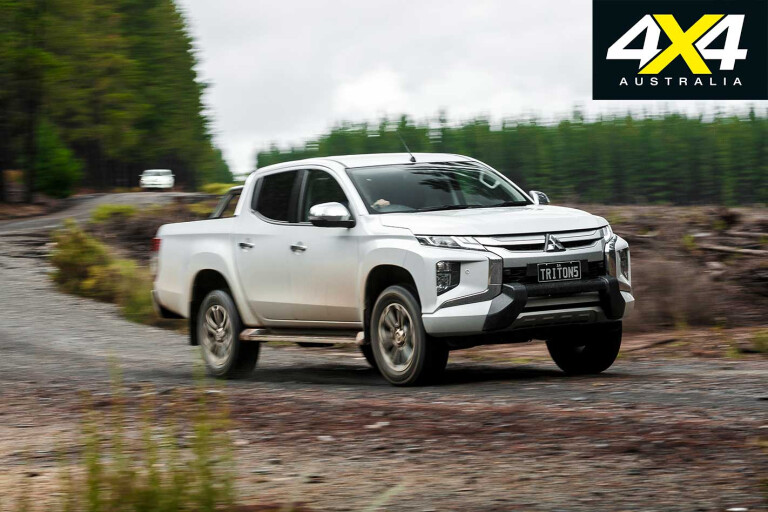
THE Triton Super Select 4x4 system sets it apart in this company, as it does generally across the dual-cab ute class where part-time 4x4 is the norm. Super Select’s special trick is its full-time 4x4 mode, which can be used on any surface – wet or dry, sealed or unsealed – and is most useful for mixed road and mixed weather touring where road conditions constantly change.
Unlike other full-time 4x4 systems (such as VW Amarok and Mercedes Benz X-Class V6) Super Select allows the driver to select two-wheel drive, as you may do for highway cruising on dry, sealed roads.
With the benefit of Super Select’s full-time 4x4 included the new Triton continues where the old one left off, in as much as it feels generally smaller and nimbler in the wider dual-cab market. However, the changes to the rear suspension, even on this GLS Premium with the theoretically lighter-duty rear springs, have brought a noticeable deterioration in the unladen ride quality and less harmonious relationship between the front suspension and rear suspension than there was before. On smooth roads the Triton is fine, but on bumpy roads the unladen ride and stability has taken a backwards step.
Off-road
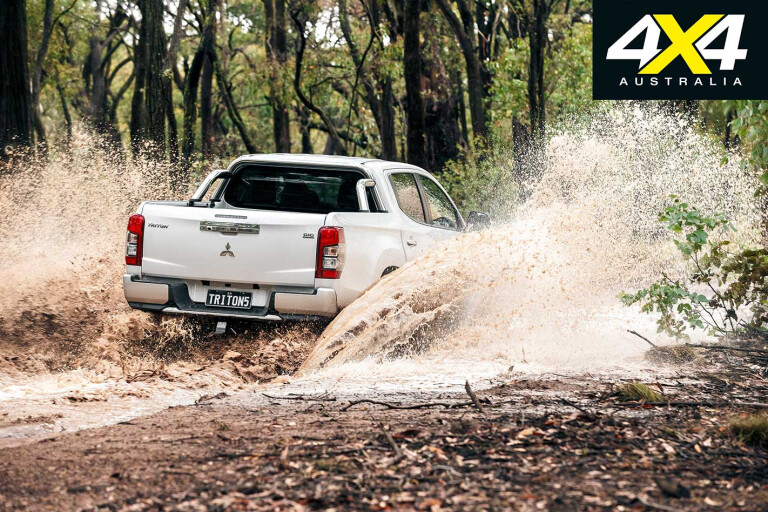
THE Triton’s new ‘Off-Road Mode’ system with terrain-specific settings becomes available when the Super Select system is in ‘Low Four’ or ‘High-Four Locked Centre’, so, in other words, when the mechanical centre diff is locked. The modes cover Mud/Snow, Sand, Rock and Gravel.
Otherwise the Triton is as it was before when off-road, which isn’t special due largely to its modest wheel travel. This top-spec model gets a rear diff lock, but it’s not always of benefit as engaging it cancels the traction control across both axles. Wading depth has risen from 500mm to 600mm and ground clearance from 205mm to 220mm, both welcome changes.
While more time in different off-road conditions is needed to fully test the effectiveness of the Triton’s new Off-Road Mode system, there’s only so much it can do given the Triton’s diffs are all mechanical and beyond any electronic control.
In this company the Triton is competitive enough off-road, but the off-road bar hasn’t been set too high in the company.
Cabin and Safety
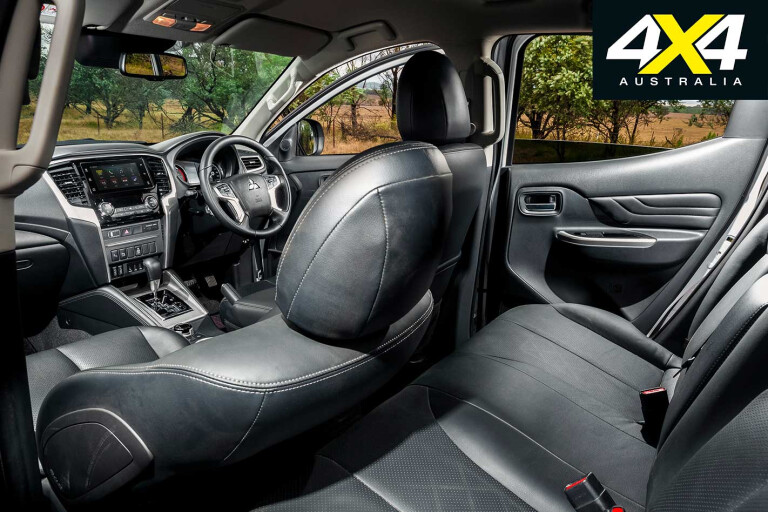
THE Triton’s cabin is the smallest here, but it’s the best finished and best presented. It’s also the only one of the three that offers tilt-and-reach steering wheel adjustment for the driver. The cabin’s relative small size is most noticeable if you wish to seat three adults across the back seat, as the D-Max and Navara both do a slightly better job.
Only the top-spec GLS Premium model gets smart key entry and start-and-heated front seats, but the Triton’s top-spec is also less expensive than the top-spec D-Max or Navara. Seven airbags, as per the Navara, help contribute to a five-star ANCAP rating; while Triton is the only ute here with blindspot warning and rear-cross traffic alert, which is a very useful feature for nose-to-kerb angle parking found in many country towns.
The new Triton has ‘Forward Collision Mitigation’ which warns the driver of a possible collision and will automatically apply the brakes if a collision is imminent, but the system apparently only works at urban rather than open-road speeds.
Practicalities

THE Triton has the lowest payload and tow rating here. The fact that its short wheelbase means just about all of the tray overhangs the rear axle doesn’t help either when heavily loaded. Surprisingly the Gross Vehicle Mass is the same for both iterations of the rear suspension system, and at 2900kg is unchanged from the previous model.
When the previous model was tested with a heavy load on-board or being towed behind, the engine did a good enough job but the chassis became very nose-up, tail-down. With the changes to the rear suspension it will be interesting to see if this has improved when put to the test with a decent payload or towload.
MITSUBISHI TRITON GLS PREMIUM SPECS:
Engine: 2.4-litre 4-cyl turbo-diesel
Max Power: 133kW @ 3500rpm
Max Torque: 430Nm @ 2500rpm
Gearbox: Six-speed automatic
4x4 System: Dual-range full-time (+2WD)
Crawl Ratio: 39.5:1
Construction: Separate-chassis
Front Suspension: Independent/coil springs
Rear Suspension: Live axle/leaf springs
Wheel/Tyre: 265/60R18 110H
Kerb Weight: 2042kg
GVM: 2900kg
Payload: 848kg
Towing Capacity: 3100kg
Towball Download (max): 310kg
GCM: 5885kg
Ground Clearance (claim): 220mm
Approach Angle: 27.5°
Ramp-over Angle: 25.0°
Departure Angle: 23.0°
Wading Depth: 600mm
Fuel Tank Capacity: 75 litres
ADR Fuel Claim: 8.6L/100km
Test Fuel Use: 10.5L/100km
MITSUBISHI TRITON 4X4 PRICES*
GXL dual-cab ute (auto): $39,990
GXL ADAS dual-cab ute (auto): $40,790
GXL+ dual-cab ute (auto): $42,490
GLS dual-cab ute (auto): $46,990
GLS Premium dual-cab ute (auto): $51,990
*Prices do not include on-road costs
What you get?
ALL Triton dual-cab 4x4s get seven airbags, tilt-and-reach steering wheel adjustment, cruise, voice-controlled Bluetooth, a touchcreen, USB port, two ISO-FIX child seat anchors, trailer sway control, and the usual electronic chassis controls.
Through no less than five equipment grades the Triton tops out with the GLS Premium, which gets smart-key entry and start, leather, heated front seats, power-adjustment for the driver’s seat, smartphone connectivity apps, auto wipers, auto LED headlights, and a suite of safety features including forward-crash mitigation, lane-departure waning, blind-spot monitoring and rear cross-traffic alert. GLS and GLS Premium models also get selectable full-time 4x4 instead of part-time 4x4. The Premium gets a rear locker.
NISSAN NAVARA ST-X - Take Three
With its coil-spring rear suspension, Nissan’s D23 Navara has been controversial from the get-go.

THE Navara D23, tagged at the time as the NP300, arrived here in mid 2015 and was a significant departure from the outgoing Navara D40, which was second only to the Hilux in sales for a good part of its near decade-long run. All but one dual-cab D23 featured a coil-sprung live axle at the rear, a feature unique among all the popular dual-cabs.
In what Nissan said was response to “feedback from customers and dealers” changes were announced a little over a year later in October 2016 and implemented for the 2017 model year. This included the dropping of the NP300 tag (replaced by Series II), the introduction a new work-spec model and, critically, new coil springs at the rear and new dampers front and rear. Then in early 2018 the rear suspension was revised again with new coils and new dampers, the steering ratio and weighting were changed and the equipment adjusted.
Powertrain and Performance
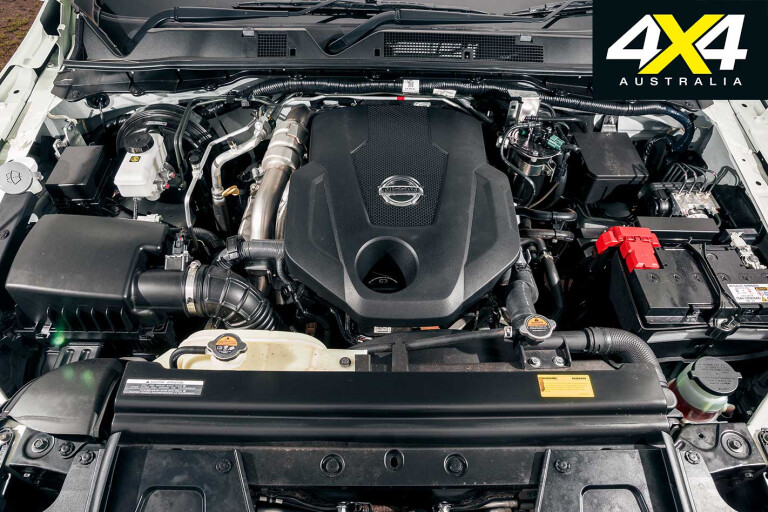
THE Navara’s Renault-sourced engine is the smallest here and is unique in as much as it has two turbos rather than one, so it’s both more sophisticated and more complex. Similar bi-turbo systems are not uncommon on other small capacity European diesels.
At 140kW and 450Nm it claims the most power and torque of the three engines here while also reaching its 450Nm maximum torque output at just 1500rpm, 500rpm before the D-Max and a full 1000rpm before the Triton reach their respective 430Nm best.
All this is the benefit of having two turbos, where the small, quick-spooling one is there specifically to enhance off-idle performance, leaving the main turbo to get on with the job at higher engine speeds and under higher engine loads.
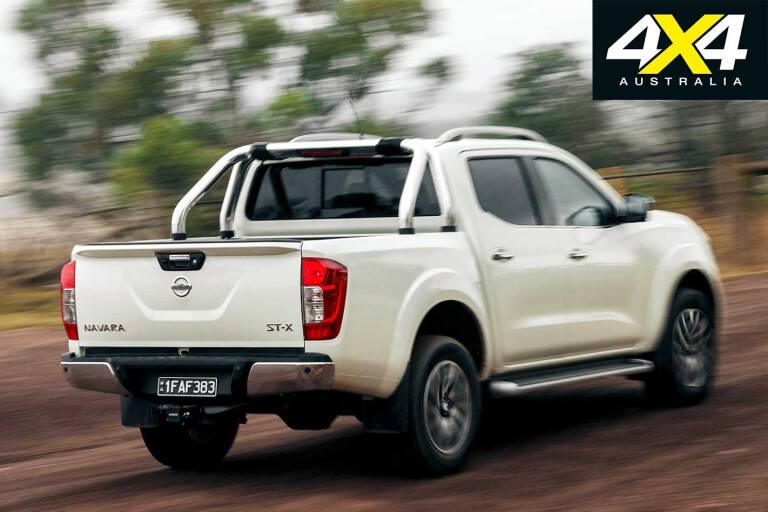
On the road the Navara proved stronger in acceleration than the D-Max, as it always has done, but was outdone by the Triton which despite the new six-speed auto still looked the slower on paper. After all, the Navara has a seven-speed automatic, is fractionally lighter than the Triton and has slightly shorter overall gearing.
The Navara’s engine is still effortless enough in general driving, but it gets noisy and more fussed when worked hard. Its overall refinement is behind that of the Triton, and even the usually gruff D-Max engine beats it for refinement under light engine loads such as level-road highway cruising.
On-road ride and Handling
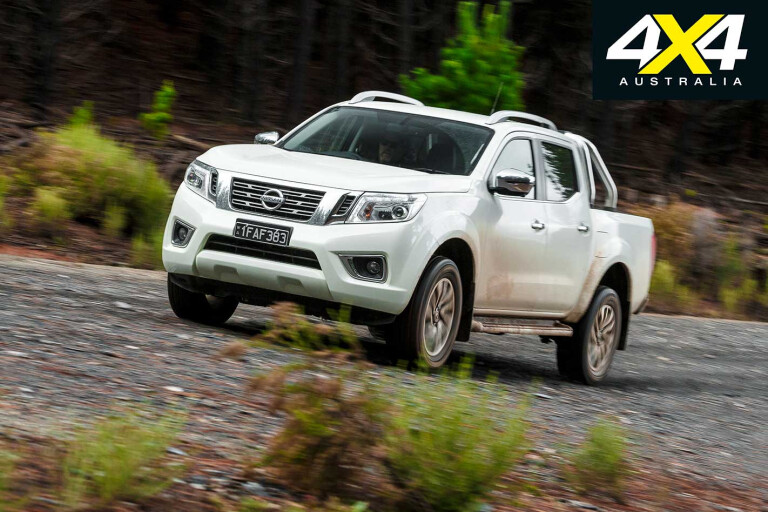
THANKS to the significant work Nissan put into the Navara’s suspension and steering in the 2017 and 2018 upgrades, the on-road driving experience is vastly improved from what it was. In its original iteration, the D32’s unladen ride didn’t live up to the promise of its coil-sprung rear end, the steering was heavy and slow, and the 3500kg towing claim (or indeed the 800kg+ payload claim) was more marketing hype than anything the Navara could do with any sort of conviction in the real world.
Now the Navara feels much better In terms of its unladen ride and handing. On poor quality roads in this company it’s generally better than the Triton in both ride and stability and, while it’s still not quite as compliant as the D-Max, its handling is as good. Still, it’s nothing special as the ride-and-handling bar isn’t set very high amongst this trio.
Off-road
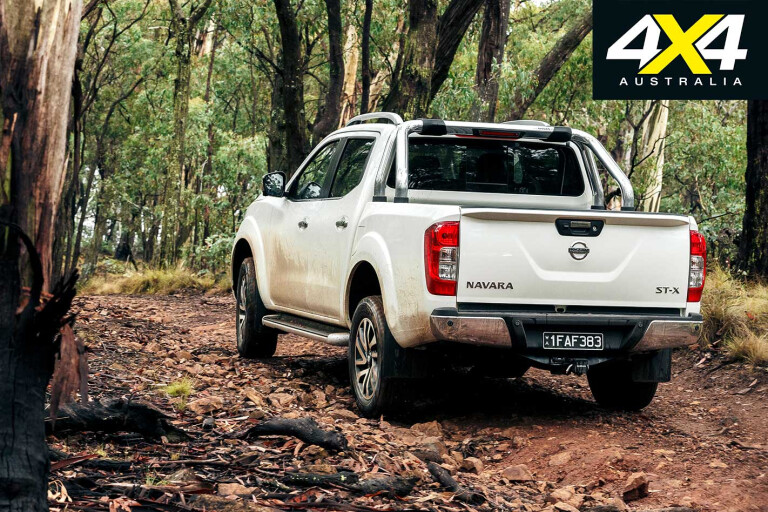
THE Navara has never been particularly capable off-road as it’s not overly endowed with suspension travel and is relatively low slung. Compared to every other popular dual-cab it’s always the first to run out of clearance off-road.
The lack of suspension travel is in part overcome by the fact the ST and ST-X models have a rear locker and, just as importantly, when the locker is engaged the electronic traction control remains active on the front axle.
On tractive ability alone that puts the Navara in front of the D-Max and the Triton, but the lack of ground clearance and low recommended maximum wading depth (just 450mm), due to the engine air intake being located under the bonnet lip, are notable negatives in this company. The Navara’s raised bonnet edges are also annoying off-road as they restrict the driver’s vision.
Cabin and Safety

THE Navara’s cabin is a little bigger than the Triton’s, but not quite as big as the D-Max. It’s also mid-field in terms of its finish and presentation; smarter than the D-Max but not as polished as the Triton. The seats up front are comfortable, but there’s no steering wheel reach for the driver. In the rear seat the shoulder room is as good as it gets, but there’s not as much legroom as the D-Max and there’s no centre headrest.
The top-spec ST-X has plenty of kit, especially for the price, with leather, heated front seats and lumbar adjustment for the driver. There’s also the option of a sunroof, something unique in this class – before the last equipment adjustment, the sunroof was standard on the ST-X.
A sliding section in the centre of the rear window is another feature unique to the Navara, while no fewer than seven airbags help contribute to the five-star ANCAP safety rating.
Practicalities
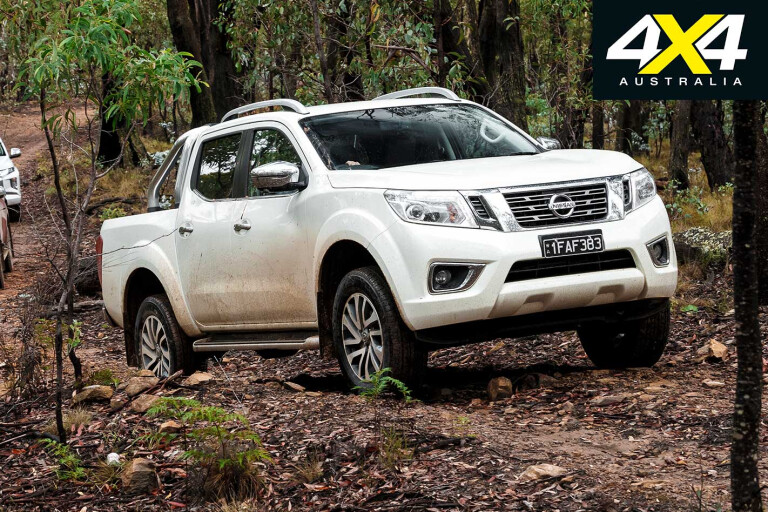
THE Navara claims a 3500kg tow rating. At 300kg, though, its maximum towball download is the lowest here. The Navara’s GVM (and therefore payload) and GCM figures, like those of the Triton, are quite low by overall class standards.
Since its run of chassis revisions we haven’t tested the Navara with a 3500kg tow load hooked on behind, but we have tested it with 650kg in the tub and three people on board – effectively maximum payload – and while it was acceptable it wasn’t as good as a D-Max when subjected to the same test, or most of the other utes tested at the time. The bottom line is that if you want a heavy-duty tow and load ute the Navara is certainly well down the list.
NISSAN NAVARA ST-X SPECS:
Engine: 2.3-litre 4-cyl bi-turbo diesel
Max Power: 140kW @ 3750rpm
Max Torque: 450Nm @ 1500-2500rpm
Gearbox: Seven-speed automatic
4x4 System: Dual-range part-time
Crawl Ratio: 44.6:1
Construction: Separate-chassis
Front Suspension: Independent/coil springs
Rear Suspension: Live axle/coil springs
Wheel/Tyre: 255/60R18 108H
Kerb Weight: 1980kg
GVM: 2910kg
Payload: 930kg
Towing Capacity: 3500kg
Towball Download (max): 300kg
GCM: 5910kg
Ground Clearance (claim): 228mm
Approach Angle: 32.4°
Ramp-over Angle: 23.8°
Departure Angle: 26.7°
Wading Depth: 450mm
Fuel Tank Capacity: 80 litres
ADR Fuel Claim: 7.0L/100km
Test Fuel Use: 10.4L/100km
NISSAN NAVARA 4X4 PRICES*
SL dual-cab ute (auto): $46,400
ST dual-cab ute (auto): $49,690
ST-X dual-cab ute (auto): $54,490
*Prices do not include on-road costs.
What you get
ALL Navara dual-cab 4x4s have seven airbags, a rear-view camera and a 12-volt outlet in the rear tub. The SL then adds LED headlights with DRLs, while the ST gains 16-inch alloys, seven-inch touchscreen, sat-nav, fogs, side steps, a chrome ‘sports bar’ and a rear locker.
The top specification ST-X model then gains leather seats (heated up front), electric adjustment for driver’s seat, a slide-opening in the rear window and fore-and-aft adjustable tub tie-downs unfortunately mounted too high in the tub to be useful for anything but tall loads.
THE SCORECARD - Across the Line
There can only be two winners.

PICKING a winner from any group of dual-cab 4x4s is difficult as they perform so many diverse roles: they can be weekday family transport, weekend off-road escape machines, tow-tugs for caravaners, or work, trade or farm vehicles, or some combination of that lot. That’s why they are so popular and lead the sales charts in the overall new car market.
In many ways the three here are similar. All of them sit at the more affordable end of the dual-cab market, and they can all do the all of the roles asked of a dual-cab 4x4 with varying degrees of success.
The least convincing of the three is the Navara, despite the fact it’s a far better ute than it was when it first appeared in 2015. At that time it didn’t feel like any great advance from the D40 it superseded and, in terms of performance, was a big step back given the V6 diesel that appeared in the D40’s latter years. For off-road duties it’s the least suitable of these three straight out of the showroom, as its various updates have only addressed tow and load performance and on-road dynamics.
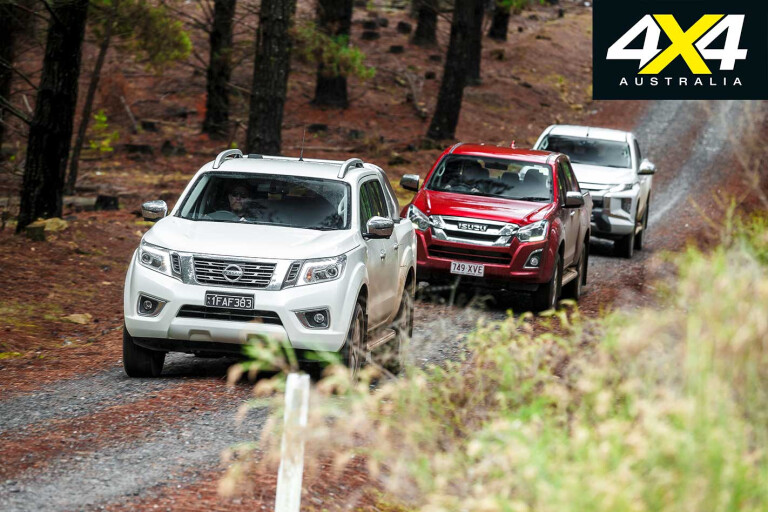
Separating the other two comes down to intended role. As a general duty ute the Triton is the pick. It’s both smaller and more manoeuvrable, thanks to its shorter wheelbase, so it can be handier in confined surrounds.
It’s also more refined, sportier to drive, and nippier performance-wise than the D-Max. Its clever Super Select 4x4 system, particularly the full-time 4x4 mode, brings a significant advantage in terms of day-to-day functionality and primary safety. It’s also more sharply priced, better equipped (new active safety features included) and better finished inside.
It’s just a pity that with the new suspension tune the unladen ride and handling on bumpy roads is poorer than it was before. Perhaps with this new rear suspension calibration it will carry or tow heavy loads better, but it would have to carry and tow significantly better to make up for the deterioration of its unladen performance. Still, this should be a relatively easy fix via an aftermarket suspension specialist.
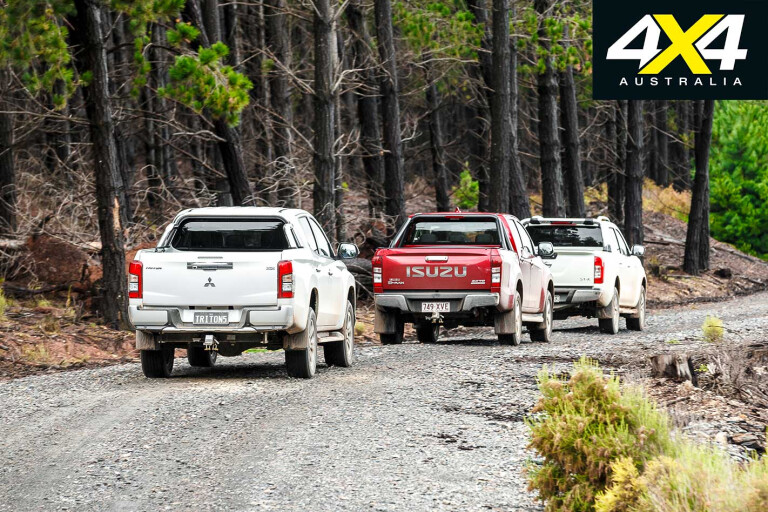
The D-Max is the winner for heavy load carrying and towing thanks to its chassis and relatively large capacity engine. It has a bigger and more useful tray, too, and more payload and tow capacity than the Triton.
In this company it’s the easy winner for any significant tow and load duties; even in our recent six-way heavy duty combined load and tow test, which included all the heavy hitters including Ranger 3.2 and the V6s from VW and Mercedes-Benz, the D-Max performed well. It may have gone into that heavy duty load and tow test as the backmarker, but it came out more as a mid-fielder.
In more general day-to-day driving its general refinement and performance is also much better than it was. At times it can be quite pleasant to drive, something that would have been a stretch before the recent upgrades. A well-proven, reliable and relatively easy and cheap to service powertrain is also a significant ownership bonus.

COMMENTS